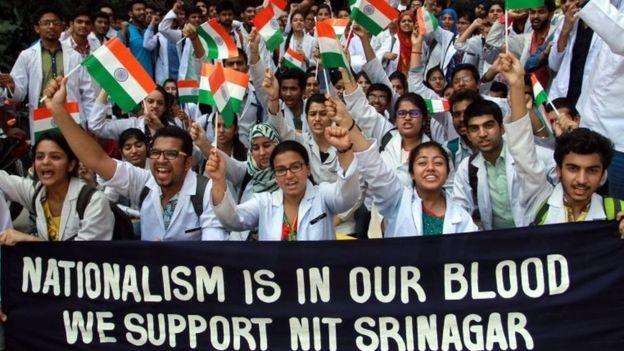Viewpoint: Why mass funerals spur violence in Kashmir
- Published

Burhan Wani's funeral was attended by thousands of people
Militant leader Burhan Wani's death in a gun battle with government forces in Indian-administered Kashmir has sparked a spiral of deadly violence in the Muslim-majority valley. The region has seen an armed insurgency against Indian rule since 1989. Sushil Pandit writes on the reasons behind the fresh upsurge of violence.
Kashmir Valley has erupted yet again.
This time, everyone blames it on the death of militant leader Burhan Wani in a gun battle with security forces in July.
Last time violence of similar scale erupted in Kashmir was in 2010, when more than 100 people died in clashes between protesters and security forces. Then the violence had begun after a Srinagar teenager, Tufail Ahmed Mattoo, was killed by a teargas shell.
'Healing touch'
Between these two incidents, in 2013, Afzal Guru, was hanged for the 2001 attack on India's parliament and buried in the Delhi prison where he was executed.
He had a profile several times bigger than both Wani and Mattoo put together. Yet, Guru's execution did not lead to any major violence in the valley.
Living in the shadow of curfew in Kashmir
Why the Kashmir killings could have been avoided
Firing at stone-throwers in Indian-administered Kashmir
Concern in Kashmir over police pellet guns
Why Kashmiri youth supported militant Burhan Wani
Kashmiri Hindus: Driven out and insignificant
In the name of providing a "healing touch" and "reaching out" to the separatists, governments led by mainstream parties in Kashmir have routinely released rebels from jails and allowed public funerals for slain militants, external. Wani's was only the latest, and indeed the largest, of the mobilisations for a frenzied funeral.

The clashes began after popular militant commander Burhan Wani was killed by security forces
Days before his killing, the Kashmir government freed more than 600 stone-pelters from prisons and pardoned them as a "confidence building measure" even as mobs were attacking security forces with stones, external during operations.
Besides, for the past two years in Kashmir, bodies of even Pakistani terrorists killed in operations have been handed over to local mosques for public funerals, which have been attended by thousands.
The Kashmir government alone cannot be blamed for this. Last July, Prime Minister Narendra Modi's BJP government in Maharashtra allowed a huge public funeral of Yaqub Memon, , externalafter he was executed for his role in the 1993 Mumbai serial bombings that killed 257 people and wounded 1,400 others.
Such mass funerals achieve two objectives for the separatists.
Halo of martyrdom
For one, they help whip up secessionist passions.
Two, they create a halo of martyrdom around the dead militants, which, in turn, helps recruit several eager replacements from school dropouts looking for some glory.
Kashmir's two mainstream political parties have not been helpful.
Though they declare their allegiance to India and its secular democracy, their politics is something else.
Between them they demand self rule, autonomy, open borders and shared sovereignty with neighbouring Pakistan, sharia-compliant banking,, external and reducing the role of the Supreme Court, federal auditors and the Indian election panel, among other things.

Police stations and military installations have been attacked in violent clashes across the region
To the hundreds of thousands of persecuted and exiled Kashmiri Hindus, the parties have paid only lip-service to their demands of justice.
When it comes to the issues of their return to the valley and resettlement, these parties prevaricate exactly as the separatists do.
Rationalising secession
Jihad - as the terror groups in Kashmir and their promoters in neighbouring Pakistan call their campaign in Kashmir - has two faces.
First are the rebels and their armed insurgency, aided and abetted directly by the terror groups across the border. They operate in independent cells spread out across the valley, with their command and control structures based in Pakistan.
And then there is the separatist leadership - Hurriyat Conference, the political umbrella of separatist groups - who provide intellectual legitimacy to rebels by articulating their positions and rationalising secession.
Perpetuating it or unwittingly helping them are the so-called "mainstream" political parties in the valley which contest elections and operate under the oath of the Indian constitution, but are seen to coordinate very closely with the separatists.
Then there is a tiny elite, comprising politicians, journalists, lawyers, bureaucrats, think-tanks, and public intellectuals, who wield a disproportionately high say in how the Indian state must respond to the crisis in the region.
An enormous amount of "insight" and "scholarship" has been invested in trying to placate the separatists in the hope that they will give up their demand.
This includes exploring all that can be offered to resolve the dispute, including "creative" interpretation of the constitution or even amendments that sometimes amount to almost secession from India. Nothing has worked.
Meanwhile, separatism in Kashmir becomes a lucrative economy and a hive of vested interests. And India continues to suffer.
Sushil Pandit is a Kashmiri Hindu in exile, living in Delhi

A brief history of Kashmir
1846 - Creation of the princely state of Kashmir.
1947-8 - Kashmir's Maharaja hesitates over whether to join India or Pakistan, prompting the two countries to go to war over the territory.
1949 - Kashmir is partitioned between India and Pakistan, with a ceasefire line agreed.
1962 - China defeats India in a brief war in a dispute over the Aksai Chin border area.
1965 - Second India-Pakistan war over Kashmir ends in a ceasefire.
Rise of Kashmiri nationalism: Jammu Kashmir Liberation Front is founded with the aim of forming an independent state through the reunification of Indian-administered and Pakistan-administered Kashmir.
1972 - Simla Agreement: India and Pakistan formalise the ceasefire line as the Line of Control as part of a new resolve to negotiate differences after their war which ended in Bangladesh splitting from Pakistan.
1980-90s - Kashmir insurgency: Discontent over Indian rule leads to armed resistance, mass protests and a rise in Pakistan-backed militant groups. Tens of thousands of people are killed.
1999 - India and Pakistan engage in a brief conflict after militants cross the Line of Control into the Indian-administered district of Kargil.
2008 - India and Pakistan open trade route across the Line of Control for the first time in six decades.
2010 - Anti-India protests in Indian-administered Kashmir in which over 100 youths are killed.
2015 - Political watershed: Elections in Jammu and Kashmir see India's ruling Hindu nationalist BJP party emerge as a major political player in the region for the first time when it forms part of a coalition government with the regional Muslim People's Democratic Party.

- Published10 July 2016

- Published8 April 2016
